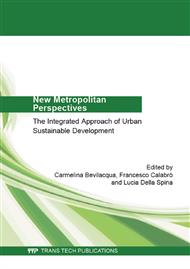[1]
C. Potsiou and C. Ioannidis: Informal Settlements in Greece: The Mystery of Missing Information and the Difficulty of Their Integration into a Legal Framework. In: Promoting Land Administration and Good Governance, 5th FIG Regional Conference, Ghana (March 8-11, 2006).
Google Scholar
[2]
Rodopi Prefecture, Recommendations of spatial planning (in Greek), Ministry of Urban Development, Housing and Environment, Athens (1984).
Google Scholar
[3]
Strategic Development Research Plan of Prefecture of Rodopi (in Greek), edited by Rodopi-Evros Super Prefecture, Rodopi Prefecture, Local Union of Municipalities and Communitites, Regional Development Agency of Rodopi, Research Committee DUTH, Komotini (2006).
Google Scholar
[4]
A. Aravantinos: Urban planning for a sustainable development of urban space (in Greek), University Studio Press, Athens (1997).
Google Scholar
[5]
B. Edgar, J. Taylor, Housing, in: P. Roberts, H. Sykes: Urban Regeneration: a Handbook, SAGE Publications Ltd, London (2000), pp.153-175.
Google Scholar
[6]
G. Voulgaris, A. Voulgarakis, G. Zaglis, X. Kolovos, G. Selinas, D. Kalivas: Depiction and comparative analysis of the spatial distribution of urban green in 11 Greek cities (in Greek), Agricultural Univ. Athens, Dep. Agricultural Economics&Rural Development, Athens (2010).
Google Scholar
[7]
Bioclimatic Design&Urban Regeneration for Sustainable Development, edited by Dimitra Babalis, Edizioni Polistampa, Firenze (2003).
Google Scholar
[8]
C. Kennedy, S. Pincetl, P. Bunje: The study of urban metabolism and its applications to urban planning and design, Environmental Pollution, 159 (2011), p.1965-(1973).
DOI: 10.1016/j.envpol.2010.10.022
Google Scholar
[9]
P. Newman: Sustainability and cities: extending the metabolism model, Landscape and Urban Planning 44 (1999), pp.219-226.
DOI: 10.1016/s0169-2046(99)00009-2
Google Scholar
[10]
E. Andrikopoulou, A. Giannakou, G. Kafkalas, M. Pitsiava-Latinopoulou: City and urban policies for the urban sustainable development (in Greek), Kritiki, Thessaloniki (2007).
Google Scholar
[11]
S. Pincetl: Urban Metabolism and the Nature of Sustainable Cities, interview to Jon Christensen, The Huffington Post (2013). Information on http: /www. huffingtonpost. com/green.
Google Scholar
[12]
E. Andreadaki: Bioclimatic planning. Environment and sustainability (in Greek), University Studio Press, Thessaloniki (2006).
Google Scholar


